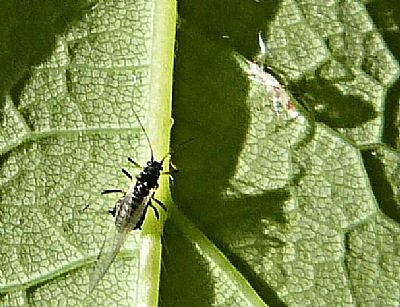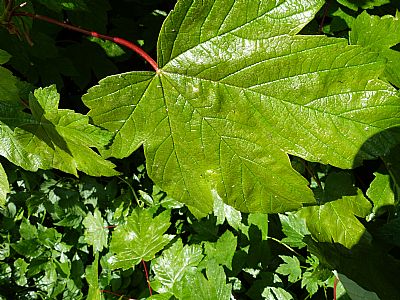HONEYDEW
Also see : SYCAMORE & SYCAMORE APHID
You most likely know that honeydew is created by aphids and that ants are known to care for aphids in return for this substance. Wikipedia tells us more:
Honeydew is a sugar -rich stickyliquid, secreted by aphids ..... and some other insects as they feed on plant sap. When their mouthpart penetrates the ploem, the sugary, high-pressure liquid is forced out of the anus of the insects, allowing them to rapidly process the large volume of sap required to extract essential nutrients present at low concentrations. ... Some caterpillars and butterflies and some moths also produce honeydew. In addition to various sugars, honeydew contains small amounts of amino acids, other organic compounds, and inorganic salts with its precise makeup affected by factors such as insect species, host plant species, and whether a symbiotic organism is present. [Wiki].
Phloem is the complex tissue, which acts as a transport system for soluble organic compounds within vascular plants.
The phloem is made up of living tissue, which uses turgor pressure and energy in the form of ATP to actively transport sugars to the plant organs such as the fruits, flowers, buds and roots; the other material that makes up the vascular plant transport system, the xylem, moves water and minerals from the root and is formed of non-living material. [Biology Dictionary].
The most noticeable signs of honeydew locally is in the shiny and sticky surface of sycamore trees. Thousands of tiny sycamore aphids produce this.
Many ants crave honeydew for its sweetness. When an ant finds an aphid, it will tickle the creature with its antennae. The aphid exudes a droplet of honeydew into a basket-like ring of bristles around its tail end, called the trophobiotic organ, and the ant drinks it down.
Without ants to imbibe it, the honey-tasting liquor splashes onto leaves lower down the tree or bush. It looks like dew, hence the name. A host of grateful insects will sip it, including honeybees, bumblebees, flies and some butterflies.
But aphids feeding under leaves often squirt their liquid waste away from the tree or bush. This is the source of the tacky residue you find on cars parked under sycamore or linden trees. [Discover Wildlife].
In Norse mythology, dew falls from the ash tree (another species that is so affected) to the earth, and according to the Prose Edda book Gylfaginning, "this is what people call honeydew and from it bees feed."
In Greek mythology, méli, or "honey", drips from the Manna–ash (Fraxinus ornus), with which the Meliae, or "ash tree nymphs", nursed the infant god Zeus on the island of Crete (as in the Hymn to Zeus by Callimachus). [Wiki].

Sycamore aphids on the underside of sycamore leaves.

And the shiny sticky upper surfaces completely covered in honeydew.
BIOLOGY DICTIONARY : https://biologydictionary.net/phloem/#google_vignette
DISCOVER WILDLIFE : https://www.discoverwildlife.com/animal-facts/insects-invertebrates/honeydew
WIKIPEDIA : https://en.wikipedia.org/wiki/Honeydew_(secretion)

